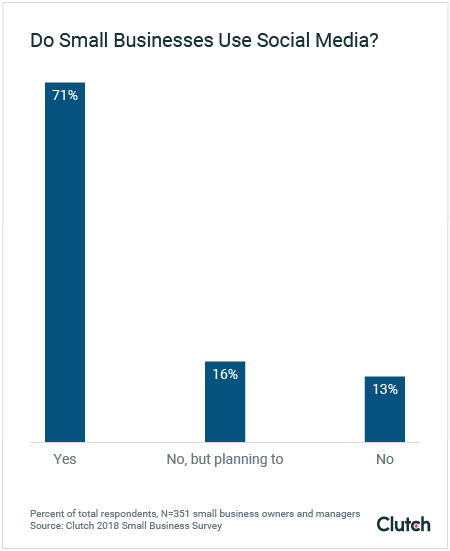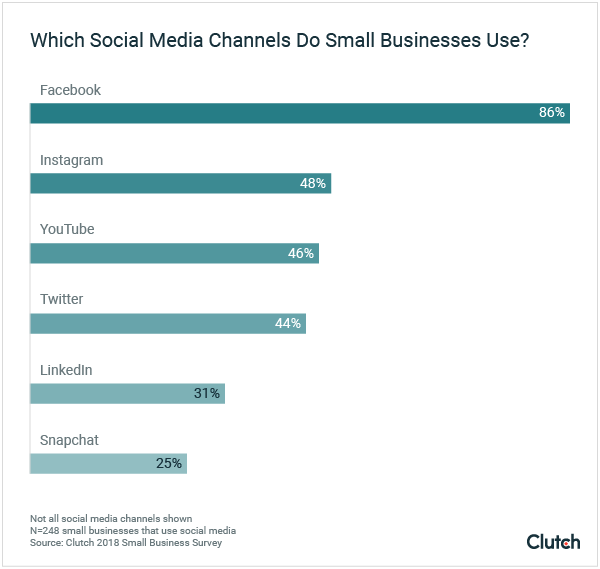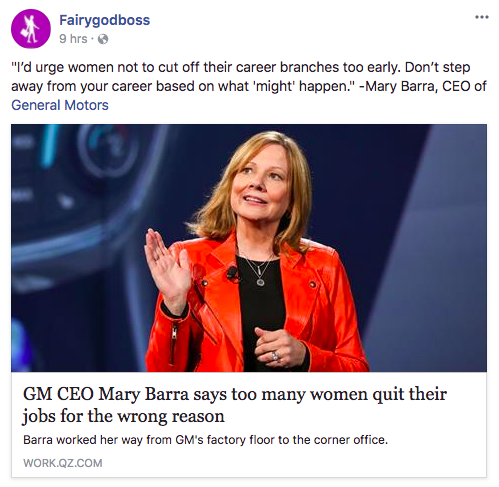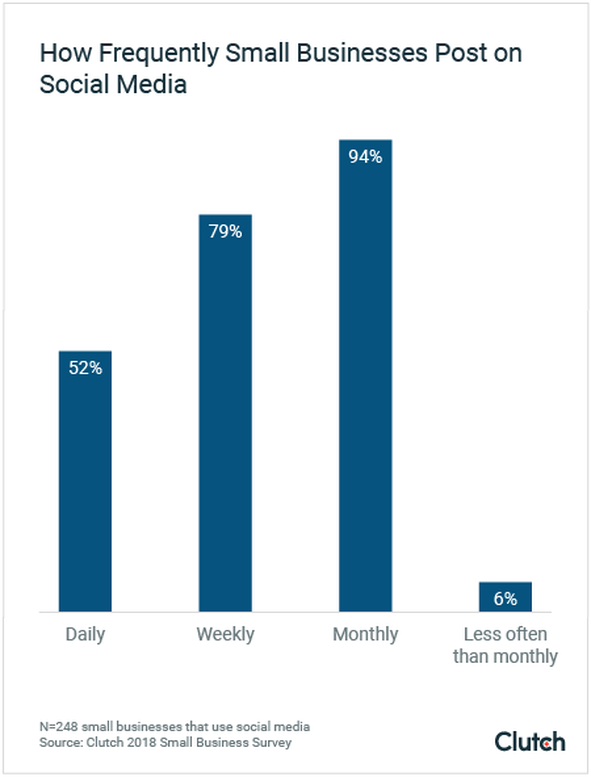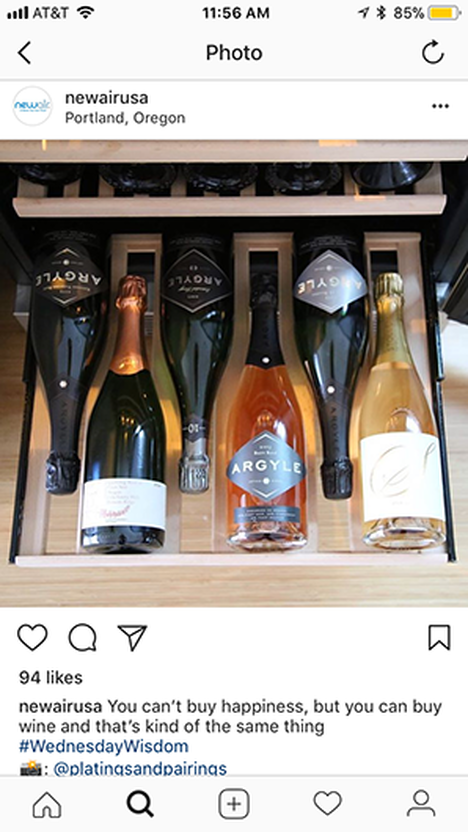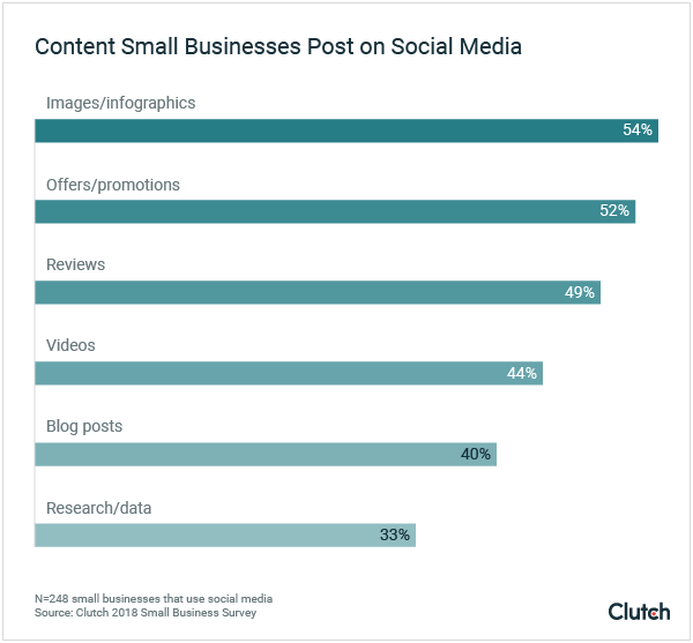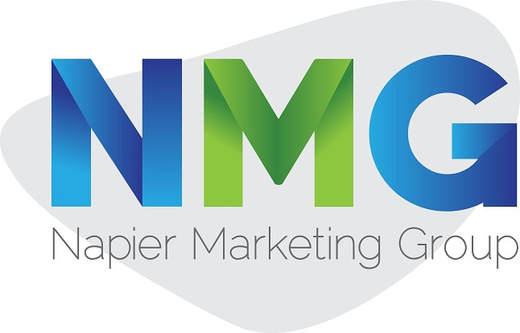HOW SMALL BUSINESSES plan to USE SOCIAL MEDIA IN 2018
part 1
read part 2 - here
March 22, 2018
Submitted By
By Kristen Herhold
Content Developer & Marketer, Clutch
By Kristen Herhold
Content Developer & Marketer, Clutch
Over 70% of small businesses use social media, according to a survey of more than 350 small business owners. The survey analyzes how small businesses use social media, including the platforms they use, the frequency they post, and the types of content they share. Business owners can use the data when planning their social media strategy.
Ten years ago, just 7% of the U.S. population(link is external) used at least one social media channel. Now, that number is up to 65% and increasing.
The majority of people are on social media, and businesses of all sizes can use the technology to reach current and potential customers in ways not possible before the internet.
Clutch surveyed 351 small business owners and managers at companies from across the U.S. with fewer than 500 employees to determine their social media habits, the channels they use, and the types of content they post.
Small businesses can use this report to learn how other businesses use social media and to improve their own social media strategies.
Ten years ago, just 7% of the U.S. population(link is external) used at least one social media channel. Now, that number is up to 65% and increasing.
The majority of people are on social media, and businesses of all sizes can use the technology to reach current and potential customers in ways not possible before the internet.
Clutch surveyed 351 small business owners and managers at companies from across the U.S. with fewer than 500 employees to determine their social media habits, the channels they use, and the types of content they post.
Small businesses can use this report to learn how other businesses use social media and to improve their own social media strategies.
Our Findings
- Nearly three-fourths (71%) of small businesses use social media, and 47% began before 2017.
- Facebook is the most-used social media channel (86%), nearly double the second-most-used channel, Instagram (48%).
- Women-owned businesses (74%) are more likely than men-owned businesses (66%) to use social media, a reflection of the fact that more women use social media.
- More millennial business owners (79%) use social media for their business than business owners older than 35 (65%) because millennials have a greater comfort level with social media.
- More than half (52%) of small businesses post to social media at least once per day, something social media experts recommend.
- The majority of businesses post images/infographics (54%) to their social media pages because people process images better than text.
Most Small Businesses Use Social Media
|
Whether they have one employee or 500, most small businesses use social media.
Of the 71% of businesses that use social media, 47% began using it before 2017, and 24% began using it in 2017. Just 13% of companies have no plans to use social media in the future, a number that should be 0%, according to Jeff Gibbard, chief social strategist at digital agency I’m From the Future(link is external). “I’m surprised 100% of companies aren’t on social media,” Gibbard said. “It’s 2018. Social media is a necessity. All companies should have at least somewhat of a social media strategy.” "I'm surprised 100% of companies aren't on social media. It's 2018. Social media is a necessity." Any small business forgoing social media risks falling behind the competition. |
Facebook Reigns Supreme for Small Businesses
|
Despite the increase in popularity of newer social media channels such as Instagram and Snapchat, Facebook is still the most-used channel. Almost all small businesses (86%) use Facebook. For many small businesses, such as Sugarplum Studio(link is external), which offers cake-decorating workshops and parties in Cherry Hill, N.J., Facebook helps reach potential customers. “Facebook is where we put the majority of our effort,” said Sugarplum Studio Marketing Manager Steve Spatucci. Though Sugarplum Studio hosts events for adults, the majority of its workshops and party guests are children. Because of this, it uses Facebook to target women ages 35 to 44, the parents of those potential guests. |
Sugarplum Studio successfully reaches its target audience on Facebook; 97% of its website visitors who come from social media come from Facebook.
In fact, Facebook is so popular that more than one-tenth of small businesses (12%) use only that platform for social media.
In fact, Facebook is so popular that more than one-tenth of small businesses (12%) use only that platform for social media.
Facebook is popular among businesses because it is the biggest platform for consumers – the social media giant has more than 2.13 billion users(link is external) as of Q4 2017 and is growing.
“I think Facebook is so popular because it is multi-generational,” said Charlotte Chipperfield, CEO of social media marketing agency Chipperfield Media(link is external). “You’re seeing grandparents, parents, and grandkids all interacting on Facebook.”
Many groups of people use Facebook, so it makes sense that businesses also use it, especially if they want to target a range of potential customers.
“I think Facebook is so popular because it is multi-generational,” said Charlotte Chipperfield, CEO of social media marketing agency Chipperfield Media(link is external). “You’re seeing grandparents, parents, and grandkids all interacting on Facebook.”
Many groups of people use Facebook, so it makes sense that businesses also use it, especially if they want to target a range of potential customers.
Women Business Owners More Likely to Use Social Media
Data shows that more women than men use social media(link is external) for their personal use, so naturally, more women-owned businesses use social media than men-owned ones.
- Women-owned businesses (74%) are more likely to post on social media than men-owned businesses (66%) because women are more social in general.
- “Women are generally better conversationalists than men,” Gibbard said. “They tend to be more expressive and more emotive. It’s no surprise to me why more women business owners use social media.”
- Women tend to be more communicative than men, and this translates to the online world, where they are more likely to use social media effectively.
|
Fairygodboss(link is external), for example, is a women-owned company that provides job and company reviews for women.
Because more women are on social media, Fairygodboss can more easily reach its target audience. “There’s a huge opportunity for women entrepreneurs to collaborate and promote each other’s brands on social,” said Editorial Associate Liv McConnell. “It’s about creating not only a community within our followers but using social media to create a community of women entrepreneurs, movers, and shakers, too.” Fairygodboss uses social media to successfully connect with its target audience of women. With women more likely to be on social media, it makes sense that more women-owned businesses are also on social media. |
More Millennial-Owned Businesses Use Social Media
Millennial business owners ages 18 to 34 are more likely to use social media for their companies than Generation X and baby boomer business owners 35 and older. This is indicative of millennials’ higher personal usage of social media.
About 79% of millennial business owners use social media, while 65% of Generation X and baby boomer business owners combined use it.
Millennial-owned businesses use social media more because they see its value.
“The older people didn’t grow up with social media, so many don’t understand how to use it for their business,” said Shawn Alain, president of social media agency Viral in Nature(link is external). “They went through a significant part of their life without even the internet, and they remember what it was like to not have a smartphone or email.”
Generation X and baby boomer business owners have lived – and possibly run businesses – before the age of social networks, so this group doesn’t always see the need for social media.
“Millennials, on the other hand, don’t know anything different and cannot imagine a life before the internet,” Alain said.
About 79% of millennial business owners use social media, while 65% of Generation X and baby boomer business owners combined use it.
Millennial-owned businesses use social media more because they see its value.
“The older people didn’t grow up with social media, so many don’t understand how to use it for their business,” said Shawn Alain, president of social media agency Viral in Nature(link is external). “They went through a significant part of their life without even the internet, and they remember what it was like to not have a smartphone or email.”
Generation X and baby boomer business owners have lived – and possibly run businesses – before the age of social networks, so this group doesn’t always see the need for social media.
“Millennials, on the other hand, don’t know anything different and cannot imagine a life before the internet,” Alain said.
Millennials don't know anything different and cannot imagine a life before the internet." Millennials’ greater personal use of social media means they are more likely to have social media profiles for their businesses.
For example, My Millennial Guide(link is external), a personal finance website that gives financial advice to millennials, was founded by millennial Brian Meiggs. Meiggs knows of social media’s importance in reaching My Millennial Guide’s target audience. “By posting topics that millennials are interested in, such as ways to pay off student loans or invest, more millennials learn about my brand and my website,” Meiggs said. “This leads to more clicks to my site and potential sales later down the road.” Because millennial business owners, like Meiggs, understand social media and use it themselves, they can more easily post topics that appeal to their audience, which can eventually lead to a sale. |
All Generations Prefer Facebook
|
The majority of business owners in every age group post to Facebook, but there is a generational difference among other social media channels. Millennial business owners prefer Instagram and Snapchat over older generations because they use these channels for personal use more than older generations. “When you carry social media to your business, you’re going to use the channels you're familiar with,” said Darren Cabral, CEO of social media marketing agency Suits Social(link is external). “If you’re a millennial and are most comfortable on Instagram, chances are, you’ll be using that for your business too.” Because more millennials are on Snapchat and Instagram than older generations, it makes sense that their businesses are more likely to use those platforms as well. Older generations, on the other hand, are more likely to use LinkedIn than millennials. This is likely due to LinkedIn’s professionalism. “These older generations are in the mindset of wanting to have a professional face all the time,” Cabral said. “They’re at work and want to use a professional network for work, not have that fun factor or entertainment that Instagram brings.” Because millennials are more familiar with social media, they are more likely to know how to use the “fun” social media channels for their business, whereas older generations see LinkedIn as a professional network more suitable for their business. |
Small Businesses Post to Social Media Daily
|
The majority of small business post to their social media channels daily – something experts recommend to keep followers engaged. Of the 71% of businesses that use social media, more than half share (52%) content or engage with followers at least once a day. Just 6% of companies post less often than once per month. Shawn Alain recommends companies post to social media at least once per day. “For most companies, the ideal minimum amount is once a day across all your platforms,” he said. “If you’re getting a lot of action on your platforms, then increase your posting frequency. Many businesses don’t post enough, but there are also many who post way too much.” Small businesses should post on social media regularly but thoughtfully. They shouldn’t waste valuable time and resources by posting too much. For example, NewAir Appliances(link is external), which manufactures products such as wine and beverage coolers, portable air conditioners, and ice makers, posts to social media each day of the work week. “For most brands, I’d recommend at least once a day, but if you do more, consider posting once in the morning and once toward the end of day,” said NewAir Director of Product Marketing Andrew Stephenson. “Nothing is more annoying than a stream of posts from one brand that clogs up your newsfeed.” |
Although posting often is important, companies that post too much can annoy potential customers and lose business. A company has to find the frequency of posting that works for its unique brand.
NewAir used to post on Instagram once a month. Increasing the frequency to 20 times per month grew its follower count from 200 to 1,500 in less than six months.
Posting regularly, but not too often, can help companies grow their followers and, in turn, gain more potential customers.
NewAir used to post on Instagram once a month. Increasing the frequency to 20 times per month grew its follower count from 200 to 1,500 in less than six months.
Posting regularly, but not too often, can help companies grow their followers and, in turn, gain more potential customers.
Small Businesses Prefer to Post Images
|
Businesses prefer to share visual content on social media.
Although businesses post a variety of content, the majority (54%) post images and infographics. Most businesses post images on social media because they are more attention-grabbing than text-based content, Chipperfield explained. For example, Chicago dog-walking and pet-sitting business Rover-Time(link is external) appeals to customers on its social media accounts through images of animal clients. “We’re very connected to our customers and aware of what they love seeing and enjoy participating in,” said Rover-Time owner Julia Rohan. “The clients are looking for updates from our walkers, who photograph Rover-Time dogs out and about with our staff.” Clients want to see pictures of their dogs featured on social media, rather than a simple text-only update. Although most companies can’t post only dog images like Rover-Time, they can still post visual content that is easier for followers to process than solely text-based content. |
Small Businesses Benefit From Social Media
Nearly three-quarters of businesses use social media, but experts say this number should be higher.
Businesses that use social media can reach a broader range of people, connect with their audience, and share interesting content.
Ten years ago, the vast majority of people and businesses were not on social media. Now, 71% of small businesses use it – a number that, ideally, should be 100%.
Whether a company is women-, men-, millennial-, or baby-boomer-owned, all businesses can benefit from social media.
Businesses that use social media can reach a broader range of people, connect with their audience, and share interesting content.
Ten years ago, the vast majority of people and businesses were not on social media. Now, 71% of small businesses use it – a number that, ideally, should be 100%.
Whether a company is women-, men-, millennial-, or baby-boomer-owned, all businesses can benefit from social media.
About the Survey
- Clutch surveyed 351 small business owners or managers from across the U.S. with fewer than 500 employees.
- About 40% of the small businesses owners surveyed are aged 18 to 34; 40% are 35 to 54; 19% are 55 and older.
- About 54% of survey respondents are female, and 46% are male.
